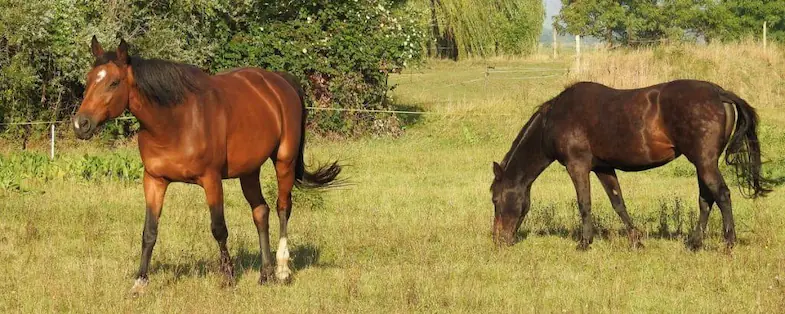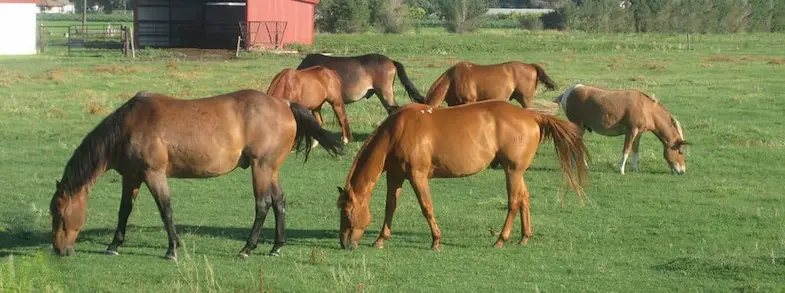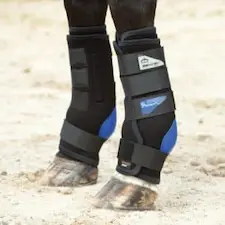Arthritis is often misunderstood and considered by many people as a joint conditional that only affects older horses but, while it is more common in mature horses, any horse, at any age, can suffer from the condition and there are a number of different causes. Sadly there is no cure for arthritis but, in many cases, it can be managed, with a lot of horses being able to continue as normal for a long time.
What is equine arthritis?
Arthritis is degeneration of the cartilage that acts as a cushion between the bones in a joint. The breakdown of the cartilage is often accompanied by the loss of the fluid that lubricates the joint and helps with its movement which is one of the reasons why it can be so painful. The pain and lack of movement can, as a byproduct, result in the horse being more prone to being lame.
There are three different types of arthritis found in horses:
- Equine osteoarthritis (OA) – As is the case with us, osteoarthritis is the most common form and is categorized by the general degeneration of the joints and cartilage. It’s also known as degenerative joint disease or DJD for short.
- Traumatic arthritis (TA) – More common it sports horses or those with an injury, it’s caused by excessive wear on a joint or joints or by repetitive impacts such as those felt by jumping.
- Equine rheumatoid arthritis (RA) – Thankfully this is relatively rare in horses but it’s an auto-immune disease where the body mistakes its own protein levels for foreign bodies and attacks them, it causes a great deal of pain, swelling and lameness.
What causes arthritis in horses?
Despite often being referred to as a disease arthritis can’t be ‘caught’, instead, there are two main causes of it:
- Wear and tear – This is the most common type of arthritis and is caused by trauma to a joint, either caused by an injury or after years of being worked. As with us, years of repetitive movement (such as walking) will cause wear and tear to the joint that can lead to arthritis. While this is common in a lot of horses certain sports, such as jumping can increase the risk. This is due to the recurring impact on the joints.
- Inflammation – Known as septic arthritis, this is actually a bacterial infection that is caused by a wound or injury. The symptoms are similar to that of arthritis caused by wear and tear (inflamed joint, swelling and a reduction of movement) but are normally restricted to one place. Being caused by bacteria means that it can be, and regularly is, treated.
What are the symptoms of arthritis in horses?
Not all horses will display the same symptoms and will also suffer from them to differing degrees but as a general rule the symptoms you need to look out for are:
- Stiffness – In the early stages of arthritis many horses will appear to be stiff as they walk. This can often go as they, and their joints, start to warm up.
- Heat – Over time the damaged cartilage will become more and more damaged which will result in the bone becoming damaged too. This will often lead to the joint feel hot as it becomes inflamed.
- Swollen joint(s) – The joint starts to wear and become inflamed it will more than likely start to swell up. It may only be visible when compared to other joints at first but over time is likely to become more noticeable.
- Lameness – While horses can suffer bouts of lameness for any number of reasons arthritis is probably one of the most common causes. Whether the arthritis is caused by wear and tear or inflammation, lameness is a common symptom.
It’s also worth noting that a horse can suffer from arthritis in one or multiple joints and while they can get it in any joint the most common are, in no particular order:
- Fetlock
- Hocks
- Carpus (knee)
- Coffin
- Pastern
- Back
What can I do to prevent my horse getting arthritis?
It’s a sad factor that osteoarthritis is, to a large extent, unavoidable in older horses, but there are things that you can to do help keep it at bay for as long as possible. Good conformation can help horses to reduce the stress they put on their joints which in turn will help. While I know there’s nothing you can do about your horse’s conformation you can make sure his feet are checked regularly and that, if he’s shod, the shoes are the best for his hooves. Reducing as much impact on your horse’s hooves/legs will also help, for example, if you complete one day rest him the next.
You can reduce the risk of traumatic arthritis by minimizing any impacts on your horse’s joints as much as possible. This can be done by looking after your horse’s hooves, have them checked and trimmed regularly but also by making sure the best types of shoes are fitted for the work you do with him.
Septic arthritis, on the other hand, is largely caused by bacteria getting into wounds and injuries so it’s important to make sure they’re kept clean and treated properly. If necessary speak to your veterinarian about using an anti-bacterial spray or powder on the wound.
How to treat arthritis in horses?
There is no cure for arthritis but just because it can’t be cured it doesn’t mean to say that it can’t be treated to some extent. As with the treatment of any illness or medical condition, the idea is to reduce the symptoms as well as, if possible, slow the onset down and arthritis is no different.
Treating arthritis with diet
Depending on the severity of the arthritis you may be able to treat it to some extent by increasing the amount of omega-3 in your horse’s diet but at the same time decreasing the amount of omega-6. This can be done quite easily by feeding more hay and grass and fewer grains, a good ratio of omega-3 to omega-6 is around 4:1 (although 3:1 and 5:1 are good too). The reason for this is that research has shown that this often reduces the inflammation and pain. If your horse’s arthritis is very bad then you may have to do this in combination with the other treatments below.
Using supplements to treat arthritis
There’s a wide range of supplements available that can ease the pain and help to support the joints, I personally use AniMed’s Pure MSM but there are plenty of other supplements such as glucosamine that also work really well.
Magnetic boots for arthritis
A lot of people suffering from arthritis have found that wearing a magnetic bracelet can help to elevate the pain and help them to move more freely and while horses obviously can’t wear bracelets you can buy special magnetic boots for them that will work in the same way. They’re purpose-made to help horses with arthritis or general joint pain and are available for different joints. You can buy them in most tack shops but I find Amazon has the best selection (and price).
Using non-steroidal anti-inflammatory drugs to treat arthritis
Your veterinarian may also suggest your horse takes a course of non-steroidal anti-inflammatory drugs (or NSAID). These work to reduce the inflammation, fight any infection, and also help to minimize the pain. The problem with NSAIDs though is that they can only be used as a short-term treatment and there are a number of side effects. While not every horse will suffer side effects they can range from treatable effects such as nausea, diarrhea, and loss of appetite to the most serious side effects such as ulcers and problems with the liver and kidneys.
Arthritis in younger horses
If your horse isn’t old but still suffers from arthritis then it’s important to find out why he is and what’s causing it. A heavy workload, exercising on hard terrain, and not being warmed up properly can all help to increase the trauma a horse’s joints suffer from. Exercise boots or bandages can help to support your horse’s joints while you’re working him so using these can certainly ease the pain.
How do I manage my horse’s arthritis?
When it comes to managing arthritis in your horse it’s important to make sure you do the following:
- Make sure your horse is a healthy weight – It’s important to keep your horse at his ideal weight because if he’s overweight this can put unnecessary stress and strain on the joints. Being overweight can also make him less agile which, in turn, will increase his chances of stepping badly and tripping, thus injuring himself. If, on the other hand, he’s underweight then his muscles are less likely to be strong enough to fully support his joints. Underweight horses are also more likely to have weaker joints.
- Have your horse’s feet trimmed regularly – If your horse’s hooves are uneven it will increase the stress on his joints because he won’t be properly balanced as he moves. Uneven hooves can also increase his chances of tripping.
- Keep your horse moving – Don’t overdo it but light exercise will not only help to keep the joints supple but also strengthen the muscles and tendons that support them. If the muscles and tendons are stronger then the natural wear and tear of the joints will be reduced.
- Warm-up before exercise – Before you exercise your horse gently warm him up by walking him around for a few minutes. It’s also important to do some simple stretching exercises so that your horse doesn’t have any bunched up muscle.
- Warm down after exercise – Depending on how much work your horse has done warming down can be extremely beneficial. If he’s hot then walking him up and down until he’s cooled down will not only help to cool him down but will also bring his heart rate back to normal.
- Take care where you ride and turn your horse out – If your horse is regularly having to walk across hard, uneven and loose ground then it’s going to increase the stress on his joints.
Can I ride my horse if they have arthritis?
There are a lot of horses with arthritis that continue to be ridden but at the same time, there are also a lot that aren’t able to do so. With this in mind, the only sensible answer to the question of whether or not a horse can be ridden with arthritis is to speak to your veterinarian. They will know your horse as well as the severity of his arthritis, armed with this knowledge they’ll be able to tell you if you can continue to ride as well as what sort of exercise you should be giving your horse.
Further reading
- How to care for your horse’s hooves
- Why does my horse keep tripping?
- Strengthening exercises for horses
- Whe should I deworm my horse?
- How to tell if your horse is healthy
- How to stop my horse kicking?
- Why does my horse eat mud?
- Do horses have fleas?
I hope you found this article helpful. If you did I’d be grateful if you could share it please as it would really help me.
Recommended products
Over the years I have tried hundreds of different horsey products, from various blankets and halters to different treats. Some I’ve loved, others I’ve hated but I thought I’d share with you my top all-time favorite products, the ones I never leave the yard without. I’ve included links to the products (which are in no particular order) that I really think are great.
- Horse Knots by Reference Ready – If you’re like me and enjoy pocket reference guides then you’ll love this knot tying guide. These handy cards can easily fit in your pocket or attach to the saddle for quick reference. They’re waterproof, durable and are color coded to make them easy to follow.
- Mane ’n Tail Detangler – Even if you never show your horse you’ll need to detangle his tail from time to time (and possibly his mane too) which is always a challenging chore! I’ve found that if I run a little bit of detangler through my horse’s tails every few days it stops them from getting matted up and makes combing them easy, even if they’re coated in mud. I don’t know if I should admit to this or not but it also works wonders on my hair.
- TAKEKIT Pro clippers – Over the years I’ve tried a lot of different clippers and while some were obviously better than others I found these to be by far the best. They are heavier than a lot of other clippers but for me, that’s a good thing, it makes them feel more sturdy and hardwearing. On top of that they have a range of speeds so are just as good for clipping your horse’s back as they are his face. I also like the fact that they come in a handy carry case but that’s not for everybody. The company that makes them is super good and incredibly helpful too, a real bonus these days. The only thing I wasn’t keen on was the fact that it doesn’t come with any oil, but that’s not a major problem as it’s not difficult to buy lubricant.
- Shire’s ball feeder – There are so many boredom buster toys out there but I like to use these every day, regardless of whether or not my horses are bored. I find that it helps to encourage my horses to problem solve by rewarding them with treats (or pieces of fruit) but it also mimics their natural grazing behavior which helps to keep them calm and de-stressed.
- Horse safe mirror – This is a strange one that many people are surprised about but I like to put horse safe mirrors in the trailers as well as in the quarantine stalls. It helps to prevent the feeling of isolation by giving the impression of other horses being around. Being herd animals horses can get extremely stressed when they feel that they’re on their own but with these stick-on mirrors, they believe that at least one other horse is with them.
- Rectal thermometer – I know this isn’t glamourous at all but it’s vital for your horse’s well-being to be able to check their temperature and a rectal thermometer is the easiest way of doing this which is why I’ve added it to the list.
Shopping lists
I’ve also put together a few shopping lists of essential items that I’ve found helpful over the years. I’ve broken the lists down into different categories rather than put everything in one massive list 😉




